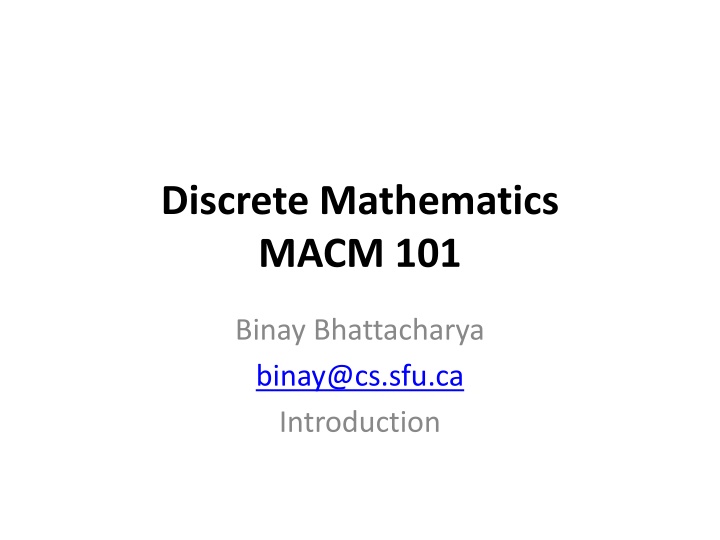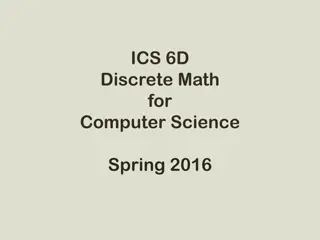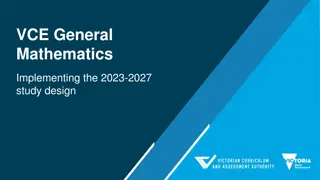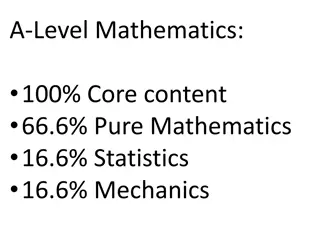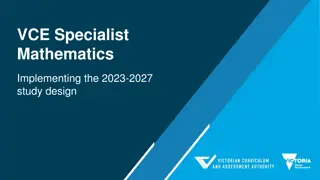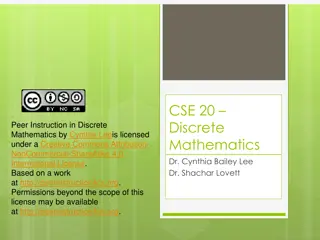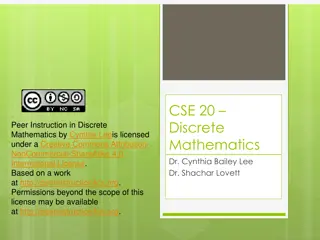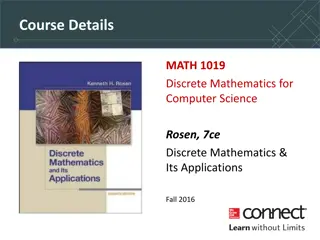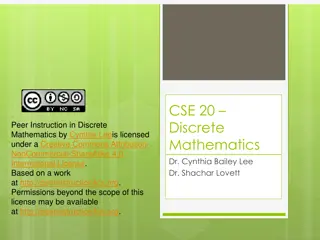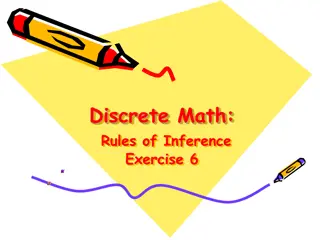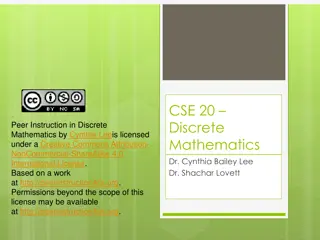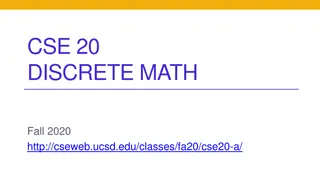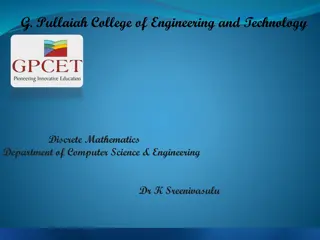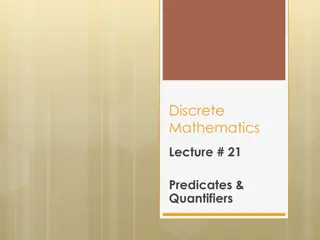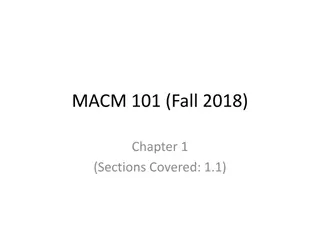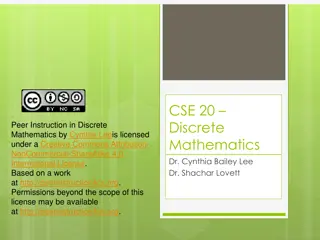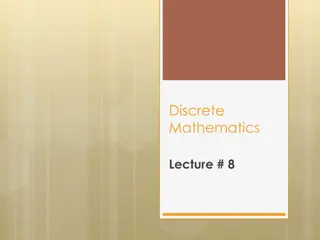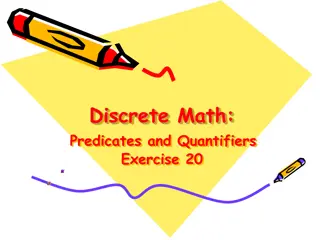Introduction to Discrete Mathematics Course
Discrete Mathematics MACM 101 taught by Binay Bhattacharya covers important themes, goals, and syllabus information. The course includes lectures on Mondays, Wednesdays, and Fridays with additional office hours available for students. Topics like Continuous vs. Discrete Mathematics are explored, emphasizing mathematical techniques for computing. The course provides exercises and resources for comprehensive learning in discrete mathematics.
Download Presentation

Please find below an Image/Link to download the presentation.
The content on the website is provided AS IS for your information and personal use only. It may not be sold, licensed, or shared on other websites without obtaining consent from the author.If you encounter any issues during the download, it is possible that the publisher has removed the file from their server.
You are allowed to download the files provided on this website for personal or commercial use, subject to the condition that they are used lawfully. All files are the property of their respective owners.
The content on the website is provided AS IS for your information and personal use only. It may not be sold, licensed, or shared on other websites without obtaining consent from the author.
E N D
Presentation Transcript
Discrete Mathematics MACM 101 Binay Bhattacharya binay@cs.sfu.ca Introduction
Overview Course Information Course themes, goals Syllabus
Course Information Lectures: Mon, Wed, and Fri 12:30 pm 1:20 pm Lecturer: Binay Bhattacharya Office: TASC I 8017 Phone: 778-782-3133 Email: binay@cs.sfu.ca Course Website: www.cs.sfu.ca/~binay/2019/macm101 All the hand-outs/announcements can be found in the website.
Other Office hours (TBA) feel free to stop by whenever you have a question, particularly if you are having trouble Catching up is very difficult once you get behind Exercises solve as many problems as possible lots of solved problems can be found in the lecture slides odd numbered questions in the text are solved in the text hints to the even-numbered questions will be provided ask TA or the instructor for help
What is discrete mathematics? Discrete mathematics is the mathematics of computing
What is MACM 101 about? Continuous Math vs Discrete Math Discrete mathematics is the mathematics of computing Why is it computer science? Mathematical techniques for Discrete Math
Continuous vs Discrete Continuous Mathematics Objects vary continuously Example: analog wristwatch: from analog perspective, between 10:30 am to 10:31 am there are infinitely many possible times Differential equations Sine, cosine functions
Continuous vs Discrete Discrete Mathematics Objects vary in a discrete way Example: digital wristwatch: from analog perspective, between 10:30 am to 10:31 am there are infinitely finitely many possible times. A digital watch does not show split seconds. Integers --- core of discrete mathematics Computer science computers are discrete.
What is MACM 101 about? Why is it computer science?
Number Theory: RSA and Public-key Cryptography Alice and Bob have never met but they would like to exchange a message. Eve would like to eavesdrop. E.g. between you and the Bank of Montreal. They could come up with a good encryption algorithm and exchange the encryption key but how to do it without Eve getting it? (If Eve gets it, all security is lost.) CS folks found the solution: public key encryption. Quite remarkable that is feasible.
Automated Proofs: EQP - Robbin s Algebras are all Boolean A mathematical conjecture (Robbins conjecture) unsolved for decades. First non-trivial mathematical theorem proved automatically. The Robbins problem was to determine whether one particular set of rules is powerful enough to capture all of the laws of Boolean algebra. One way to state the Robbins problem in mathematical terms is: Can the equation not(not(P))=P be derived from the following three equations? [1] P or Q = Q or P, [2] (P or Q) or R = P or (Q or R), [3] not(not(P or Q) or not(P or not(Q))) = P. [An Argonne lab program] has come up with a major mathematical proof that would have been called creative if a human had thought of it. New York Times, December, 1996
Coloring a Map How to color this map so that no two adjacent regions have the same color?
Graph representation Coloring the nodes of the graph: What s the minimum number of colors such that any two nodes connected by an edge have different colors?
Probability and Chances Importance of concepts from probability is rapidly increasing in CS: Randomized algorithms primality testing; Google s PageRank, just a random walk on the web!) in computation, having a few random bits really helps! Machine Learning / Data Mining: find statistical regularities in large amounts of data. Natural language understanding dealing with the ambiguity of language
Goals of MACM 101 Introduce students to a range of mathematical tools from discrete mathematics that are key in computer science. How to write statements correctly. How to read and write theorems. Areas: Counting Logic Set Theory Mathematical Induction Relations Functions Introduction to Graphs
Goals of MACM 101 Introduce students to a range of mathematical tools from discrete mathematics that are key in computer science. How to write statements correctly. How to read and write theorems. Areas: Counting Logic Set Theory Mathematical Induction Relations Functions Introduction to Graphs Note: Learning to do proofs from watching the slides is like trying to learn to play tennis from watching it on TV! So, do exercises!
Acknowledgement Taken some slides from Prof. Bart Selman slides: www.cs.cornell.edu/courses/cs2800/
